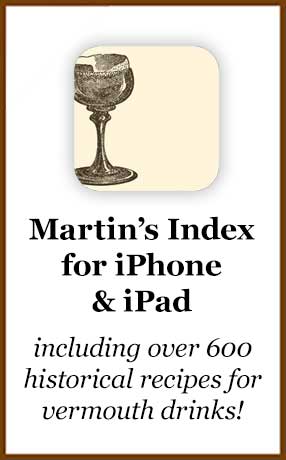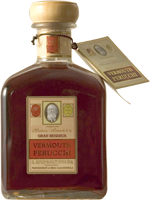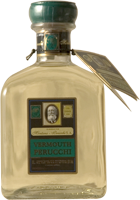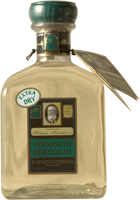
Vermouth by Brand
Unavoidably, this guide is not exhaustive. Many vermouths are regional products that don’t get exported to the U.S., and admittedly, the listings here are biased toward the U.S. marketplace. However, the marketplace is fluid, and we will add more listings as adequate information becomes available.
Atsby
New World vermouth producer based in New York City. Products utilize wines from the North Fork of Long Island (Chardonnay) and fortification with apple brandy from upstate New York. The Amberthorn product is drier, has 21 botanicals, and is sweetened with honey. The Armadillo Cake is sweeter, has 32 botanicals, and is sweetened with caramel. Neither wine contains wormwood, and neither is immitative of any traditional style of vermouth. Introduced in September 2012.
- Amberthorn NON-TRADITIONAL: WESTERN DRY
- Armadillo Cake NON-TRADITIONAL: WESTERN DRY
Web site: //atsbyvermouth.com/
Alessio
Vermouths introduced in 2014 at the behest of Tempus Fugit Spirits, and employing late-19th Century recipes.
- Rosso
- Vermouth Chinato
- Bianco
Belsazar
New Berlin-based vermouth brand.
- Dry*
- Red*
- Rosé* NON-TRADITIONAL: MODERN
- White*
*To our knowledge, none of these products are currently imported to the USA.
Web site: //www.belsazar-vermouth.com
Boissiere
(bwah-zee-AIR)
Originally, Boissiere was a major Chambéry brand. In 1971, production in Chambéry ended and the brand was re-applied to a Torino vermouth, Bosca Cora (see Cora, below), for certain export markets.
- “Bone White” Dry
- Sweet vermouth [rosso]
Carpano
(car-PAH-no)
Antonio Benedetto Carpano is the individual traditionally credited, perhaps posthumously, with inventing the commercial model for what we know today as red Italian vermouth. The Carpano brand was formalized some years later (1860s?) by Carpano’s nephew. Today, Carpano production is in Milano, Italy.
- Punt e Mes (“Point-and-a-half”)
- Antica Formula
- Carpano Classico*
- Carpano Bianco
- Carpano Dry
*not imported to the USA
Punt e Mes dates to around 1867 and is simultaneously amongst the bitterest and sweetest of vermouths. Punt e Mes is a common example of a vermouth chinato, a style of vermouth with extra quinine. (Adulterating Vermouth di Torino with bitters or vanilla flavoring—almost like a cockail—when drinking it is an Turinese custom dating back at least to the mid-1800s, as documented by Arnaldo Strucchi; chinato has bitters built-in. Although it is not typically described or marketed as such, Punt e Mes can be thought of as a bottled vermouth cocktail. Punt e Mes is Carpano's top-selling vermouth.
Antica Formula is a highly-regarded product first introduced in the 1990s. Antica Formula is an example of the vermouth alla vaniglia style: a red vermouth with added vanilla flavoring and sugar to balance. Note: Antica Formula is based on an old recipe, but it is not Carpano’s original vermouth recipe.
Carpano Classico is the contemporary expression of the product that was ostensibly Carpano’s original commercial vermouth. Its similarity to that original product is dubious. It is, at the least, a pretty good red vermouth.
Carpano Dry was introduced in 2014.
Web site: //www.carpano.com (The Carpano brand is currently owned by the Milanese firm Branca.)
Also, see this vintage promotional booklet (PDF-12MB) containing an official history as well as interesting visual materials. The date of this booklet is unknown (1970s?), but it predates the brand’s acquisition by Branca and the relocation of production to Milan.
Cinzano
(chin-ZAH-no)
Originally the brand of successful liqueur manufacturer from Pecetto that can trace its history to 1757. In 1815, Cinzano relocated to Torino and essentially took over from Carpano (for a while) as the officially sanctioned producer of Vermouth di Torino, based on Carpano's model. The brand lives on and is one of the world's most recognizable spirits brands to this day. Check the label for current production. Like Martini, Cinzano is one of the longstanding, mass market leaders.
- Rosso
- Bianco
- Extra Dry
- Rosé* NON-TRADITIONAL: MODERN
*not imported to the USA
Cinzano recently introduced fruit-flavored vermouth products in select European markets.
Web site: //www.cinzano.com (The Cinzano brand is currently owned by Davide Campari-Milano S.p.A.)
Cocchi
(KOE-kee)
The house of Cocchi is a Torino winery known for an array of still, sparkling and fortified muscat wines. In 2011 they revived their house vermouth, resulting in the first genuine Vermouth di Torino (protected designation of origin) available in the USA in many years. Production is in Torino, Italy.
- Vermouth di Torino [rosso]
- “Dopo Teatro” Vermouth Amaro [chinato]
Web site: alpenz.com or //www.cocchi.com


Contratto
(con-TRAH-toe)
Prominent sparkling wine producer in Piemonte. New ownership has brought their 19th Century vermouth and americano products back into production, with emergent distribution in the United States.
- Contratto Vermouth Rosso
- Contratto Vermouth Bianco
Web site: www.contratto.it


Cora
(COR-uh)
Another early Torino producer that was, for a time, the officially sanctioned producer of Vermouth di Torino. Cora was the first Torino producer to begin exporting their product as well as the first vermouth exporter to the United States market (1838) as well as to South America. Cora grew quite successfully until World War II, then went into decline, and was eventually purchased by spumante producer Bosca in 1984.
- Rosso*
- Bianco*
*not imported to the United States, but see Boissiere, above.
Dolin
Produced in Chambéry (shahm-bay-RHEE), France. Appellation d' Origine. Dolin invented and/or commercialized the blanc style (“white vermouth”) in the late 19th Century.
- Rouge
- Blanc
- Dry
Web site: //www.alpenz.com


Gallo
Produced in California, United States. Gallo, a mass market winery founded in 1933, has been producing imitative, low-priced red and dry vermouths for much of its history, mainly for the US market. Their products were ubiquitous during the mid-Century decades.
- Sweet [red]
- Dry
Gancia
(GAWN-chee-uh)
Produced in Canelli, Italy. Available in some US markets. Longstanding vermouth producer dating to c. 1850.
- Rosso
- Bianco
- Dry
Web site: //www.gancia.it/
Imbue
Produced in Portland, Oregon.
A regional artisanal aperitif product based on Oregon Pinos gris not imitative or representative of any particular European style of vermouth. Contains no wormwood.
- Imbue Bittersweet Vermouth NON-TRADITIONAL: WESTERN DRY
Web site: //www.imbuecellars.com/
La Quintinye Vermouth Royal
Novel French vermouth line introduced in 2013 (2015 in the USA). Produced in Cognac. Unique for use of pineau des charentes as the mistelle (fortification and sweetening). The Blanc and Extra Dry expressions are markedly savory in character, with leading sage and rosemary notes. The Rouge augments the profile with rich Christmas spices.
- Rouge
- Blanc
- Extra Dry
Web site: //laquintinyevermouthroyal.com



Lacuesta
Spanish vermouths from Martínez Lacuesta in Rioja.
- Edición Limitada [rojo]
- Reserva [rojo]
- Rojo
Some Lacuesta vermouths are now imported to the USA by Fasel Shenstone
Web site: //www.martinezlacuesta.com
Lo-Fi Aperitifs
Collaboration between E&J Gallo and Quaker City Mercantile producing “Western Dry” style aperitif wines (two labeled as vermouth). Wine-forward, with aromatization botanicals itemized on the label. Neither wine contains wormwood, and neither is immitative of any traditional style of vermouth.
- Sweet NON-TRADITIONAL: WESTERN DRY
- Dry NON-TRADITIONAL: WESTERN DRY
Web site: //www.lofiaperitifs.com


Lustau
Lustau is one of the largest (and best-known in the USA) sherry producers. In 2017, Lustau introduced two vermouths based on sherry.
- Lustau Rojo
- Lustau Blanco
The Lustau Rojo is built on an Amontillado, sweetened/enriched with Pedro Ximenez, and aromatized with Wormwood, Sage, Coriander, Angelica, Gentian and orange peel.
The Lustau Blanco is built on fino sherry, sweetened and enriched with moscatel, and aromatized with wormwood, gentian, rosemary, marjoram, orange peel and chamomile.
Web site: //www.lustau.es/en
MAiDENii
Novel vermouths from Australia featuring regional botanicals, including Australian-grown wormwood.
- Sweet* NON-TRADITIONAL: MODERN
- Dry* NON-TRADITIONAL: MODERN
*not imported to the USA
Web site: //maidenii.com.au
Mancino
(man-CHEE-no)
Novel vermouths created by Italian bartender Giancarlo Mancino and produced in Canelli, Italy (Asti).
- Rosso Amaranto
- Bianco Ambrato
- Secco [dry]
- Vecchio [rosso]
- Chinato
Imported to the USA by Fasel Shenstone.
Bianco Ambrato is a bianco vermouth chinato with significant chinchona and gentian components.
Vecchio is a limited edition red vermouth aged one year in Italian oak.
Web site: //www.mancinovermouth.com

Martelletti
Produced in Cocconato, Italy.
- Vermouth Classico [rosso]
Not a lot of information is readily available about this vermouth, which appeared in select markets in the USA in recent years. It appears to be made by a Piedmont winery moderately well known for their Barolo and related wines. It also appears to be exceptionally good.
Martini & Rossi
Originated in Torino, Italy, 1863, but relocated shortly thereafter to nearby Pessione. Martini & Rossi (known as Martini Sola & Cia until 1879) was agile and adept at distribution and export from the start. The firm achieved success in the U.S. market early on (beginning 1868), just as vermouth was catching on there, and they remain the market leader. Martini & Rossi is one of the world's great liquor brands, recently promoted in most markets simply as “Martini”. Check label for current production; contents may vary significantly in different markets which is a cause for concern.
Martini Rosso is the market-leading red vermouth, the de facto standard or benchmark for the style, and the best-selling vermouth in the US market. Worldwide, however, Martini Bianco (introduced c. 1910) outsells Martini Rosso. Martini Extra Dry was introduced c. 1900 and has been extremely successful in the US market since World War II.
- Rosso
- Bianco
- Extra Dry
- Rosato NON-TRADITIONAL: MODERN
- d’Oro* NON-TRADITIONAL: MODERN
- Martini Gran Lusso [chinato]
- Martini Riserva Speciale Rubino [rosso]
- Martini Riserva Speciale Ambrato [bianco]
*not imported to the USA
Martini Gran Lusso is a red vermouth chinato introduced in 2013 to celebrate Martini’s 150th Anniversary.
Additional products are available under this brand in some markets.
Web site: //www.martini.com (Martini & Rossi is part of Bacardi Limited.)
Miro
(mee-ROE)
Produced in Reus, outside Tarragona. A prominent example of Vermouth de Reus, the Catalán vermouth DO.
- Rojo
- Seco
Noilly Prat
(NWAH-ee PRAH)
Produced in Marseillan, France, near Montpelier. First and only surviving representative of the “Marseilles style” of vermouth. In addition to the regional ingredients on which it is based, barrel aging plays a definitive role in these products. Originator of the “dry vermouth” style (Joseph Noilly c. 1813 in Lyon). Large scale production began in 1843 in Marseilles under Noilly’s sons, with exports to the USA commencing in 1844. Production relocated to Marseillan in 1850. The “Original French Dry” is the current expression of Noilly’s original dry vermouth product.
- Original French Dry
- Rouge†
- Ambre NON-TRADITIONAL: MODERN
- Extra Dry (2012)††
†Originally for export exclusively to the USA market (1957); distribution is now expanding
††After World War II, Noilly Prat began exporting a lighter formulation of their dry vermouth to the USA intended to cater to American tastes, especially Martini cocktail drinkers. This product was arguably an imitation of the Chambéry dry style. Fifty years later, in 2008, Noilly Prat discontinued the special U.S. formulation and phased in the European formula in updated packaging, resulting in a fair amount of confusion and angst amongst Americans devoted to a very particular Martini habit. Sales in the US market plummetted, so in 2012, Noilly Prat put their lighter variation on dry vermouth back into production, bottled as “Extra Dry”.
Noilly Prat Ambre is a nascent hybrid product initially sold only at the factory tourist center, but distribution is expanding.
Web site: //www.noillyprat.com/
Perucchi
Vermouth producer from Cataluña, Spain. Founded in the 19th Century by D. Augustus Perucchi.
- Rojo
- Blanco
- Extra Dry
Web site: //www.perucchi.info/


Ransom
Small production, handcrafted traditional vermouths from Sheridan, Oregon distillery Ransom Spirits.
- Dry
- Sweet
Web site: //www.ransomspirits.com
Regal Rogue
Novel Australian vermouths featuring botanicals grown in Australia. As of this writing, rolling out in Australia and Hong Kong, with Europe and South America to follow.
- Rosso*
- Bianco*
- Extra Dry*
*not imported to the USA
Web site: //www.regalrogue.com



Riserva Carlo Alberto
Vermouth di Torino built on Erbaluce di Caluso and Moscato di Asti white wines.
- Rosso*
- Bianco*
- Extra Dry*
*not imported to the USA
Web site: //www.riservacarloalberto.com



Routin
Routin is the vermouth brand of Distillerie des Alpes, in Chambéry.
- Rouge
- Blanc
- Dry
Web site: //distilleriedesalpes.com
Stock
Stock is a brandy distillery based in Trieste, Italy, that applies its brand to a diverse array of products, including vermouths.
- Rosso
- Bianco
- Extra Dry
Web site: //www.stock-spa.it/
Sutton Cellars
Produced in the United States by Sutton Cellars (San Francisco, California), a small artisanal producer. Contains no wormwood and not imitative of traditional vermouth. For context, see “New World/Western Dry”.
- Brown Label Vermouth NON-TRADITIONAL: WESTERN DRY
Web site: //www.suttoncellars.com


Tribuno
Now produced in the United States by The Wine Group, an infamously faceless conglomerate that specializes in mass-market wines. Originally, Tribuno was the vermouth brand of Vermouth Industries of America, a mass market producer founded in the New York City area in 1938 by Mario Tribuno. Low cost Tribuno vermouths were ubiquitous during the mid-Century decades when they produced and sold more vermouth in the US than anyone save Martini & Rossi.
- Sweet
- Dry
Uncouth Vermouth
Locavore boutique producer of limited edition, unusually flavored vermouths out of Red Hook, Brooklyn. Contains mugwort, but is not otherwise recognizably imitative of any traditional vermouth.
- Apple Mint NON-TRADITIONAL: MODERN
- Pear Ginger NON-TRADITIONAL: MODERN
- Butternut Squash NON-TRADITIONAL: MODERN
- Beet Eucalyptus NON-TRADITIONAL: MODERN
- Serrano Chile Lavender NON-TRADITIONAL: MODERN
- Butternut Squash NON-TRADITIONAL: MODERN
Web site: //www.uncouthvermouth.com


Vermouth del Professore
Revivalist Vermouth di Torino (rosso) and bianco produced under the auspices of the Jerry Thomas Speakeasy in Rome.
- Rosso
- Bianco
Imported to the USA in limited quantities by Winebow.
Web site: on Facebook
Vya
(VAI-uh)
Produced by Quady Winery (Madera, California), a small artisanal producer of aperitif and dessert wines from Muscat varieties. Quady entered the vermouth market in the 1990s, a pioneer. None of these wines contain wormwood, and none is really immitative of any traditional style of vermouth. For context, see “New World/Western Dry”
- Extra Dry NON-TRADITIONAL: WESTERN DRY
- Sweet NON-TRADITIONAL: WESTERN DRY
- Whisper Dry NON-TRADITIONAL: WESTERN DRY
Whisper Dry was introduced in 2012.
Web site: //www.quadywinery.com/
Yzaguirre
(EES-uh-GEE-ray)
Vermouth brand of Cellar Sort del Castell near Tarragona, Spain.
- Classic Red
- Classic White
- Rosado
- Red Reserva
- White Reserva
- Dry Reserva
- Selección 1884
- Francisco Simo Y Cia
Some of Yzaguirre’s vermouths are now imported to the USA by Fasel Shenstone
Web site: //vermutyzaguirre.com
Others
To the outsider who starts digging, it would seem that nearly every man, woman and child of Torino produces their own line of vermouth. While some remain regional products or even unique to a particular restaurant, some make their way into various export markets. If you have the priviledge of traveling to Torino (or other parts of the world), you may encounter various brands not represented here. Some may be of interest, some may not be distinctive. The important thing is to be aware how common vermouths are in some regions, particularly Piemonte. Some examples, in no particular order: Barona, Chatel, Garrone, Kedem, La Canellese, Nando, Melchior, Perlino, Ponti, Rica Donna, Romanetti, Versasi.











































































